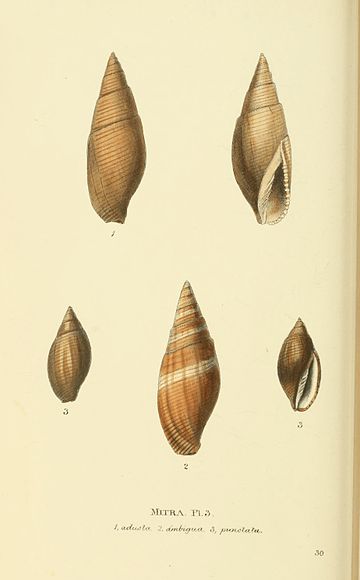Mitra. Pl. 3.
1, adusta. 2, ambigua. 3, punctata.
The different nomenclature of Lamark and Dillwyn, induced us to suspect that our present species might still be retained under the name of adusta; but as a greater degree of confusion may perhaps arise in so doing, than that which we wished to avoid, we have now given it a distinct name, and defined its true characters. It is sometimes partially dotted with pure white. The M. adusta of Lamark is, in short, the same as the ruffina of Linnæus: or at least that species which Dr. Solander and Mr. Dillwyn conceive to be such. Our shell is from the Isle of France, and is not common: the crenated teeth on the lip are very strong; the base obtuse, and effuse: the spire and aperture of equal length.
MITRA fulva.
Specific Character.
Shell ovate-acute, smooth, fulvous, unspotted, marked with transverse sulcated striæ, containing punctured dots: body whorl contracted; suture crenated: base obtuse: outer lip thickly and strongly crenated; the crenations, and the plaits on the pillar, white.
MITRA ambigua.
Shell ovate-fuciform, rufous, with a white band near the suture, transversely striated and punctured, suture and outer lip crenated, base contracted; spire shorter than the aperture.
Less distinctly striated and punctured than the last; but differs considerably in being almost a fuciform shell: the base of the aperture is consequently contracted. We possess but one specimen, and know not its locality.
MITRA punctata.
Shell ovate, brown, striated and punctured: spire very small, somewhat conic: outer lip crenated: pillar six-plaited.
A beautifully perfect shell of this new and very rare species, we procured from our friend Mrs. Mawe; we have never seen another: the inside of the lip is margined with deep brown.
